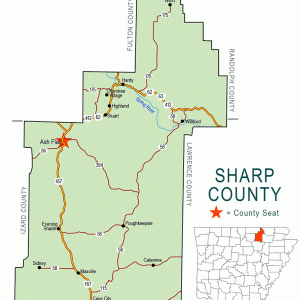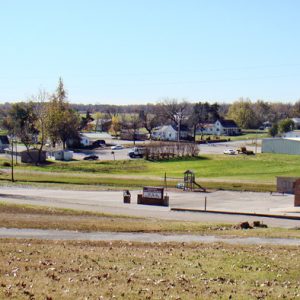calsfoundation@cals.org
Sidney (Sharp County)
| Latitude and Longitude: | 36º00’11″N 091º39’36″W |
| Elevation: | 604 feet |
| Area: | 2.09 square miles (2020 Census) |
| Population: | 192 (2020 Census) |
| Incorporation Date: | May 11, 1935 |
Historical population as per the U.S. Census:
|
1810 |
1820 |
1830 |
1840 |
1850 |
1860 |
1870 |
1880 |
1890 |
1900 |
|
– |
– |
– |
– |
– |
– |
– |
– |
– |
– |
|
1910 |
1920 |
1930 |
1940 |
1950 |
1960 |
1970 |
1980 |
1990 |
2000 |
|
– |
– |
– |
153 |
120 |
97 |
109 |
270 |
271 |
275 |
|
2010 |
2020 |
|
|
|
|
|
|
|
|
|
181 |
192 |
|
|
|
|
|
|
|
|
Sidney is a small farming community located in southwest Sharp County. While the area was settled in the 1840s, the town was not incorporated until May 11, 1935, and was believed to have been named in honor of Confederate general Albert Sidney Johnston. The town has never been home to more than 300 citizens.
Prior to 1844, John Martin settled at the confluence of the branches of what is now Sidney Creek near the present town. Within a few years, the families of George Hodges and Addison Harvey Nunn settled in the area, the former on land that would eventually become the town. Nunn, who owned the largest number of slaves in the area, was elected county and probate judge. At the time, the area was part of Lawrence County, which later became Independence County, then Lawrence again, and finally Sharp County.
Prior to the Civil War, several more families came to the area. During the war, many locals joined Confederate forces, with a smaller number enlisting to defend the Union. Many of these men enlisted in a company raised by Addison Nunn, which was mustered into Confederate service near Pocahontas (Randolph County) in October 1861 as part of the Ninth Regiment Arkansas Infantry. The unit fought in the bloody Battle of Shiloh in 1862 under the command of General Johnston. By the end of the war, the remnants of the depleted regiment were consolidated into the Twenty-first Arkansas Infantry. While no battles were fought in the Sidney area, the Federal army under General Samuel Curtis moved through the area in 1862, causing much excitement. It took some time for order to be restored to the area after the war, with bands of outlaws wandering the countryside.
On June 13, 1878, a post office was established on the outskirts of the settlement in the home of Addison Nunn. It was at this time that the developing community was given the name of Sidney, evidently due to Nunn’s admiration for General Johnston. The post office was moved into town in 1880 when a new postmaster was appointed. Each time a new postmaster was appointed, the office was moved.
The first business in the area is believed to have been the blacksmith shop located at the home of George Hodges. With cotton being a major crop in the area, William Springer built the first cotton gin by the late 1850s. In the early part of the twentieth century, the county was home to twenty-three such gins; none remain. Samuel Arnn was Sidney’s first merchant, opening the town’s first store in the 1880s. Sometime after the Civil War, his son George opened the first grist mill. About 1885, Dr. John Johnston set up his practice in the town. In 1905, Sol Yeager established the town’s first bank, which soon failed. Approximately seven years later, the Bank of Sidney was founded. Even though the nearest railroad was more than ten miles to the north, a business sector slowly began to develop by the 1880s. Still, most of the men were farmers, cultivating cotton, hay, tobacco, and more corn and hogs than any other section of the county. As a result, the town never grew to any significant size, instead becoming a convenient trade center for local farmers. By 1897, it had three general stores, one grocery, one hotel, two blacksmiths, and two cotton gins.
Sidney was home to one of the first schools in the county. By the 1850s, classes were being held in a log building also used by local worshippers. A new building was constructed in the 1870s at the lower end of Main Street. In 1894, a four-room, two-story school with an impressive bell tower opened; it was used for the next thirty-eight years. This early school was a subscription school, requiring students to pay as much as three dollars a month. By the 1920s, it had become public. In 1909, the state designated the school as County District 10. As enrollment increased, a larger field stone–veneered facility was constructed in 1931, and the National Youth Administration constructed a new gym a year later. About the same time, bus service was initiated for students. In 1952, a new elementary school was constructed, complete with indoor restrooms. By the early 1950s, many of the area’s young families began moving away, seeking employment. Dropping enrollment resulted in the school being closed at the end of the 1957 school year. In the 1970s, the buildings were demolished to make way for construction of a nursing home.
In 1856, a Presbyterian church was established in the area, and a log church was built on land donated by John Cargill. David Morrow was the first minister of a congregation called Mount Carmel. A new brick church building was constructed in 1867. When the building became uninhabitable in 1898, the church was dissolved. A second Presbyterian congregation, called Hebron, was founded in 1879. The church saw several name changes: Sidney Presbyterian Church, Campbell’s Chapel, and Sidney Cumberland Presbyterian Church. A Methodist church was founded in 1892, with W. S. Southworth as the first pastor. For many years, the Presbyterians and Methodists worshipped in the same building. Baptists had settled in the area before the Civil War, but a church was not organized until 1904.
The town was finally incorporated in 1935 amid the depths of the Great Depression. In 1958, the Extension Homemakers Club organized a St. Patrick’s Day Parade, which continues as a town tradition today. In 1973, in an effort to become eligible for federal funds, the town’s boundaries were extended to about 1,200 acres. The installation of city water attracted new residents. Also in 1973, the Sharp Nursing Home was constructed on the old school site. Since the 1970s, the population remained fairly constant, but the 2010 census recorded a sharply declined population of 181.
For additional information:
A History of One-Room Schoolhouses of Sharp County: Country School Memories. Mount Vernon, IN: Windmill Publications, 1993.
Moore, Caruth Shaver. Early History of Evening Shade and Sharp County. Evening Shade, AR: C. S. Moore, 1979.
Ogilvie, J. Craig. “A History of Sidney and its Schools.” Sharp County Journal 5 (September 1991): 1–80.
Wilkerson, P. H. “Sidney, Sharp County: One of the Garden Spots of Arkansas, Her People, Business, School and Churches.” Sharp County Record. March 5, 1897, p. 1.
Mike Polston
Encyclopedia of Arkansas History & Culture
 Sharp County Map
Sharp County Map  Sidney
Sidney  Sidney School Memorial
Sidney School Memorial 




Comments
No comments on this entry yet.